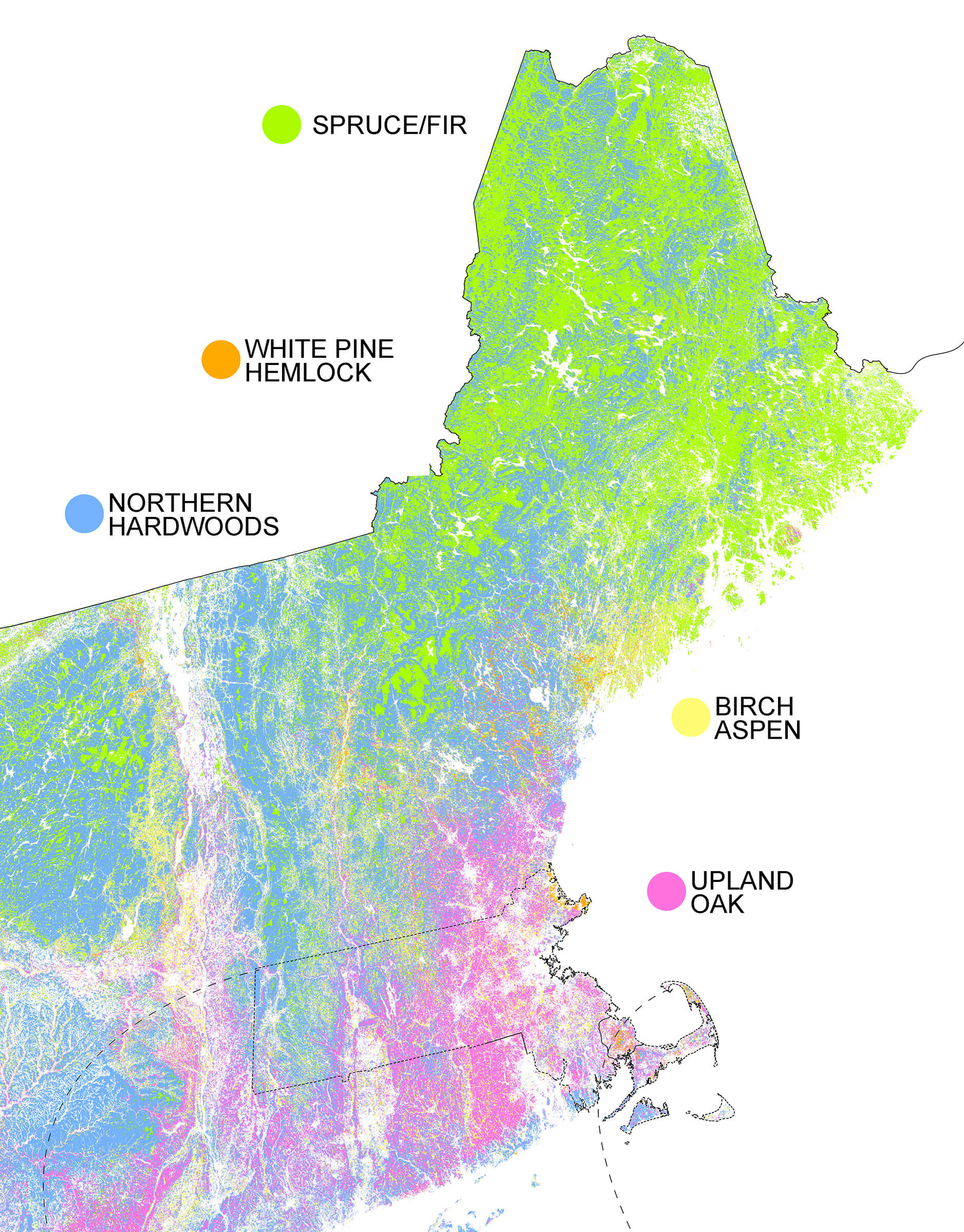There is a prevailing sense among proponents of mass timber that building with wood is inherently good. This enthusiasm is largely premised on a key assumption that if a tree sequesters carbon as it grows, then mass timber building components must count as stored carbon.
But if the source of that wood—a forest—is a source of carbon emissions, as is beginning to happen in Canada, for instance, due to drastically changing climates, then any material extracted from that source cannot magically and suddenly become a carbon sink. This is all the more true when a mass timber building component has been extracted, transported, processed, installed, maintained, and eventually demolished through carbon emission–intensive processes. Even if the timber destined for, say, cross-laminated timber (CLT) panels is extracted from a carbon-sink forest, the amount of stored carbon extracted from that forest can be quickly matched, and likely exceeded, by the amount emitted in subsequent production and transportation processes. Or to state the matter in other terms, just because you have a debit card does not mean you have any funds in your account.

To extract, and count, the stored carbon in mass timber building components as independent of both the forest and all the other terrestrial processes that engender that mass timber building component will only exacerbate—rather than ameliorate—carbon emission–based environmental problems that drive our changing climates. Our ability to properly reason about and imagine the carbon dynamics of mass timber building hinges on our ability to expand our understanding of timber to include forests.
Wood comes from forests, not just trees. Trees are but one part of a forest’s larger ecology and carbon cycle. To properly understand, and thus design, a mass timber building requires designers to begin to see the forest for the tree (assuming they even see the tree for the mass timber building component). Consider, for instance, the respective forests of New England and Quebec. The boreal forests of Quebec are very extensive black spruce stands, often held in very large ownership tracts, all in the resource extraction-intensive context of the Canadian economy. This singular species, its specific material properties, and the socio-economic context of the relevant forestry practices together suit the production of CLT panels quite well. By contrast, New England presents a very different forest. Much smaller stands of mixed hardwood species, along with a coniferous mix changing with the changing climates, characterize New England woods. Furthermore, much of the New England forest is held by a plethora of small landowners who often retain a misguided conservation ethic in which trees are never cut, at the expense of forest health, biodiversity, water quality, and resilience. In the New England context, and by extension the New York City context, CLT panels are not at all obvious as a forest product for the building industry. That is, at least in part, because smaller mass timber components, made in smaller and more diverse facilities and from a more diverse mix of species and harvesting practices, suit the forests of the northeastern states.
Such observations about the specificity of forests are merely emblematic of how architects might begin to design not just mass timber buildings and their carbon dynamics but, even better, the reciprocities of mass timber building and forest building. The ultimate merits, or environmental and social burdens, of timber building will come to bear not only on the performance of a particular building but on that building’s contributions to the dynamics of its forests. This inherent reciprocity must be researched and designed as much as the building itself. For instance, in aesthetic and formal terms, if a conventionally “beautiful” mass timber building is the result of vulgar forestry practices and material geographies, then it becomes less architecturally satisfying. Or, likewise, if a mass timber building’s shallow claims of carbon neutrality based on a life cycle assessment (LCA) serve only to mask ill-considered forestry dynamics, the final merits of its architecture—carbon and otherwise—are cast into doubt.
In methodological terms, an LCA of timber building components does not account for the forests’ biogeophysical energy, material, and information. Instead, LCA studies begin only after extraction has taken place. In other words, in the case of mass timber components, life cycle assessments paradoxically occlude the living portion of the tree and forest dynamics that do the sublime work of photosynthesis and carbon sequestration, to say nothing of the related cycling of water, biodiversity, and respiration. This imponderable occlusion makes meaningful LCA-based carbon claims dubious at best, for all the key carbon sequestration processes occur in the time and space of biogeophysical forest growth, which LCAs omit from consideration. Whether in terms of design or research, addressing this blind spot entails not expanding LCA accounts of building products, but finally engaging ecology-based descriptions of the complex forest–tree-factory–building carbon dynamics.
We need, in short, design and research methods that see the forest for the mass timber building.
To adequately consider mass timber building, then, is to rethink the systems and boundaries of conventional construction. Designers would benefit from a larger, nonlinear perspective—a more inclusive system-
boundary definition—of what exactly mass timber is and does at the scales of the building and forests. In such a definition, mass timber buildings are another type of carbon pool in the carbon cycles of a forest; a cache of carbon like that buried in forest soil or woody litter on the forest floor. In this regard, mass timber building, like any type of construction, is a territorial proposition.
It is also a unique molecular proposition. Architectural design based on the unique molecular properties of mass timber has important implications. For example, engineer Salmaan Craig is currently refining an approach to uninsulated, single-layer solid mass timber buildings that matches Passivhaus standards. Structure, enclosure, what architects call insulation, and finish materials—all in one radically integrated conception of mass timber. In Craig’s approach calibrated holes in the mass timber wall turn the structural panel into a heat exchanger. Interior heat conduction moving through the solid mass timber heats incoming, buoyancy-driven ventilation air. The approach eliminates not just insulation but also mechanical heat exchangers and other equipment. Relieving future genres of buildings of carbon-intensive, randomly sourced layers of construction and mechanical systems goes a long way toward engendering positive environmental impacts through design. Much like the unique properties of a forest, mass timber building today involves deep forays into the unique properties—and potentials—of mass timber material components as well.
From the territorial to the molecular, architects, engineers, and foresters are—together—beginning to re-engage the fundamental terrestrial character of mass timber building. They are beginning to see the forest for the building and vice versa. They are also beginning to peer into novel molecular architectures as they pioneer a new paradigm of carbon-positive building. The upside of recent mass timber building interest is that architects in particular are beginning to unlearn what modernity trained them to forget: that to understand building—both as a noun and as a verb, as components and processes—is to understand the full range of ecological, social and political relations that engender building as a broad terrestrial process.
When compared with steel and concrete, mass timber could trigger evolutionary change, a paradigm shift toward a much more ecologically sane approach to construction. But this new paradigm will not emerge from merely substituting one material for another. It is, rather, the result of a change in how designers think about building as a terrestrial process at a range of scales—that is to say, its actual ecology, its thermodynamic potentials, and its socio-economic bonds. It is a result of thinking through the construction ecology of building, with the aim not of doing less bad by minimizing environmental impacts but rather maximizing the good that design can achieve at a range of scales, through the design of building as an inherently terrestrial act.
Kiel Moe is a practicing architect and the Gerald Sheff Chair in Architecture at McGill University. He is the author of many books, most recently Unless: The Seagram Building Construction Ecology, out now from Actar.
